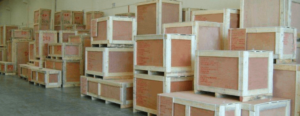Designing Wooden Boxes for Shipping? Here’s What You Should Consider
Wooden boxes are a reliable packaging option for shipping various goods. Their sturdy construction and natural aesthetic make them a popular choice for businesses and individuals alike. However, designing wooden boxes for shipping requires careful consideration to ensure the safe transportation of your items in the air, sea, and road cargo.
In this blog post, we will explore key factors that should be taken into account when designing wooden boxes for shipping, helping you create packaging solutions that are both practical and effective.
Material Selection: Choosing the right type of wood is crucial for designing sturdy and durable shipping boxes. Hardwoods such as pine wood and rubber/silver wood are commonly used due to their strength and resistance to wear and tear. It is important to select wood that is not prone to warping or splitting to ensure that boxes maintain their structural integrity throughout the shipping process.
Box Dimensions: Determining the appropriate dimensions for your wooden shipping boxes is essential for maximizing space utilization and ensuring the safe transportation of your items. Consider the size, weight, and fragility of the goods to be shipped when deciding on the box dimensions.

We are experts in designing innovative yet economical wooden packaging boxes to secure cargo. Through our solutions, we have helped many of our clients save money. Get in touch with us to know how we can help you too with your packing and securing needs.
Structural Integrity: To withstand the rigors of shipping especially in the sea, wooden boxes need to be structurally sound. You should pay attention to reinforcing the corners, edges, and joints of the boxes to enhance their strength and stability. Utilizing techniques such as finger joints, dovetails, or screws greatly enhance the overall structural integrity, ensuring your boxes can withstand rough handling and stacking.
Internal Padding and Protection: Proper internal padding is crucial for safeguarding the contents of your wooden shipping boxes. Consider using materials like foam inserts, bubble wrap, or packing peanuts to provide cushioning and protection against impacts during transit. This will help prevent damage to fragile items and minimize the risk of breakage.
Secure Closures: Choosing the right closure mechanism is essential to prevent accidental opening or shifting of the box contents. Hinges, latches, or sturdy locking mechanisms should be considered to secure all the closures.
Labeling and Marking: Properly labeling your wooden boxes for shipping is vital for effective handling and identification throughout the shipping process. Use clear and visible labels that indicate the fragility, orientation, and handling instructions for the contents. Additionally, marking the boxes with unique identification numbers or barcodes streamline tracking and logistics.
Environmental Considerations: Sustainability is a growing concern in shipping and packaging. When designing wooden boxes for shipping, consider using responsibly sourced and certified wood to minimize environmental impact. Explore eco-friendly alternatives for internal padding materials and opt for water-based, non-toxic paints or finishes.
Designing wooden boxes for shipping requires thoughtful planning and attention to detail. By paying attention to the above explained factors, you can create wooden shipping boxes that are aesthetically strong and provide the necessary protection for your valuable goods. Taking the time to design and construct these boxes correctly will ensure the safe arrival of your shipments, ultimately enhancing customer satisfaction and reducing potential losses or damages.
Our packing experts are highly qualified and experienced in designing wooden packaging boxes that can withstand any form of cargo while securing your valuable goods. Get in touch with us to discuss your requirements.


